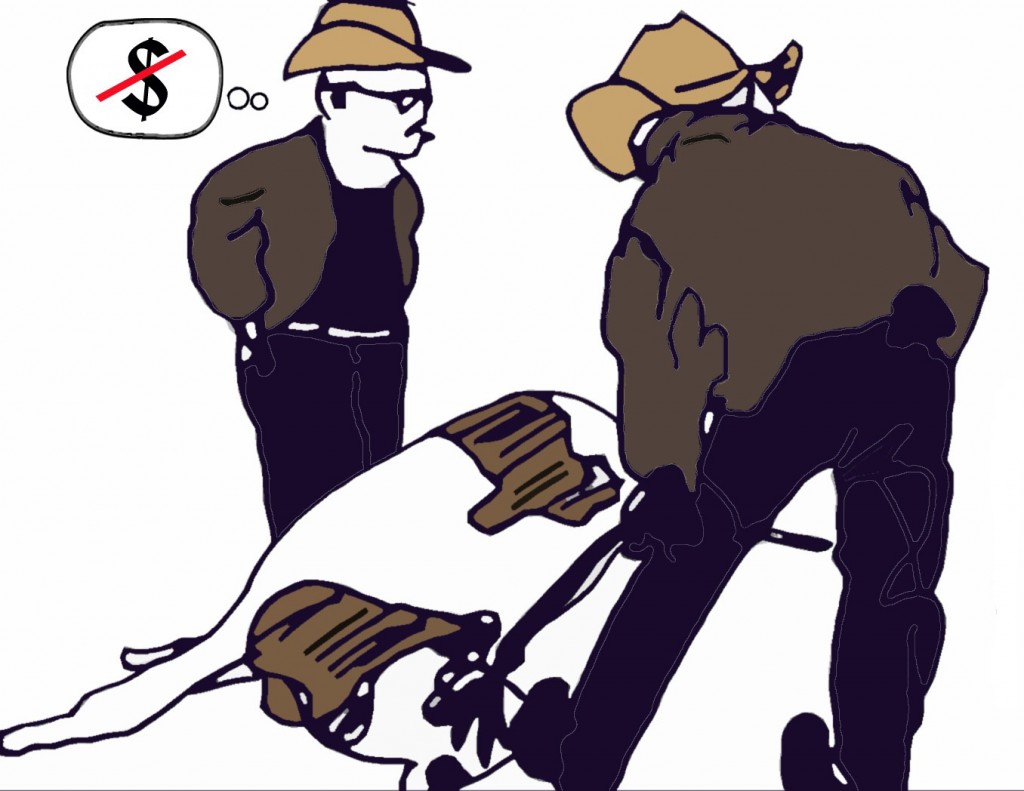Many food consumers worry about pathogens like E. coli, Salmonella and Listeria in their meat. But according to a new government report, they should worry more about veterinary drugs, pesticides and heavy metals in their food.
A new Office of Inspector General (OIG) report released last month finds the USDA’s Food Safety and Inspection Service (FSIS) fails to test for many drugs in cattle, inadequately tests for others and fails to recall meat which is clearly contaminated.
“Between July 12, 2007, and March 11, 2008, FSIS found that four carcasses were adulterated with violative levels of veterinary drugs and that the plants involved had released the meat into the food supply. Although the drugs involved could result in stomach, nerve, or skin problems for consumers, FSIS requested no recall,” says the report.
Drugs cached on the national dinner plate may include antibiotics like penicillin, florfenicol, sulfamethazine and sulfadimethoxine, the anti-parasite drug Ivermectin, the non-steroidal anti-inflammatory drug flunixin and heavy metals says OIG, which oversees Department of Health and Human Services programs.
Of 23 pesticides designated by the EPA and FDA as high risk, FSIS only tests for one says the report, in some case because no established action levels are set. Nor are there action levels for Dioxin, pesticides with cancelled registrations like lindane and fire retardants called PBDEs (Polybrominated diphenyl ethers), some of the most worrisome endocrine disruptors. Pesticides and endocrine disruptors are increasingly linked to the epidemic of childhood ADHD and asthma. Livestock antibiotics, used to produce weight in livestock with less feed, cause resistance and allergic reactions in people and, some say, weight gain.
Unlike pathogens like E. coli, says the OIG report, residues cannot be cooked away and are sometimes broken into even more harmful compounds when heated. And how was your dinner?
A quick look at FDA April inspection letters suggests the OIG report does not exaggerate.
Alan J. Svajgr of Darr Feedlots in Cozad, Nebraska is warned about the chlortetracycline and monensin, two antibiotics, he has “adulterated” his cattle feed with “contrary to the New Animal Drug Application (NADA) approvals for these drugs,” in one warning letter.
Shirlee and Thomas Jermin of Templeton Feed & Grain in Templeton, California are warned that they have not disclosed the antibiotic sulfamethazine in their Pig Starter & Grow Medicated Feed and omitted a cautionary label statement to “withdraw 15 days prior to slaughter.” Oops.
Rodney R. Land of Land Dairy in Mayo Florida sold a dairy cow for food with 0.2 parts per million (ppm) of sulfamethazine in her liver tissue and Michael D. Martin of Martin Feed Lot in Harrisburg, Illinois sold a beef heifer for food with a walloping 38.855 ppm of sulfamethazine in her liver as well as 0.1781 ppm of flunixin, say other letters.
And Hendrik G. Doelman of Elma Dairy in Rochester, Washington sold a dairy cow for food with 0.441 ppm sulfadimethoxine in her liver and 1.04 desfuroylceftiofur, a metabolite from a cephalosporin antibiotic, in her kidney tissue says another FDA letter.
And then there’s the calves. Raymond Wright of The Wright Place dairy in Clinton, Maine sold a bob veal calf with 10.99 ppm of the antibiotic neomycin in his kidney tissue thanks to unapproved use of Custom Calf White Plus NT Medicated Dairy Herd and Beef Calf Milk Replacer says the FDA and Raymond L. Martin of Corner View Dairies in Lyons, New York sold a bob veal calf with 1.83 ppm penicillin in his kidneys. And that’s just April.
Bob veal, calves under three days old and weighing only 70 to 100 pounds, represent the biggest residue risk to the food supply says the OIG audit which was sent from Gil H. Harden, Acting Assistant Inspector General for Audit to FSIS administrator Alfred Almanza.
“Farmers are prohibited from selling milk for human consumption from cows that have been medicated with antibiotics (as well as other drugs) until the withdrawal period is over; so instead of just disposing of this tainted milk, producers feed it to their calves. When the calves are slaughtered, the drug residue from the feed or milk remains in their meat, which is then sold to consumers,” says the report.
Whereas dairy cows end up in fast food hamburgers, bob calves are put in “value added” veal products like veal sausages and breaded veal patties. Heart rending descriptions of the frail animals, electric prodded into standing at livestock auctions, have appeared in agricultural reports.
Ninety percent of the residue violations cited in the report were found in dairy cows, veal calves and bob veal (to whom farmers feed “waste milk” that is “unmarketable” for human consumption) says the audit. Four plants had an astounding 211 violations which FSIS says it cannot properly monitor without a national identification program that is opposed by agribusiness.
Yet repeat violators — “individuals who have a history of picking up dairy cows with drugs in their system and dropping them off at the plant” — are widely tolerated by FSIS charges the report.
Two years ago, Americans became aware of cull dairy conditions when they saw sick and crippled cull cows fork-lifted and water-boarded to become part of the school lunch program. Where is the meat identified by the OIG report going?











